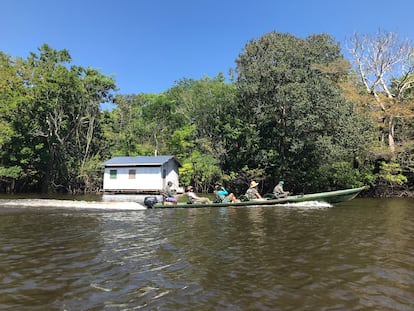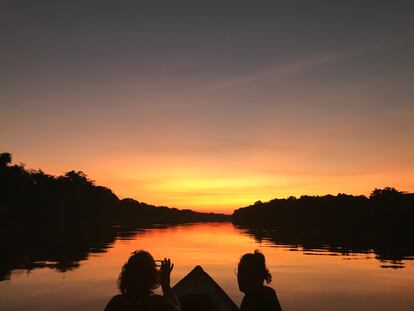Chatting with alligators in the Amazon rainforest
The Uakari ecohotel in Brazil’s Mamirauá nature reserve offers a privileged few the possibility to learn about the work of scientists, walk through the jungle, fish for piranhas and meet the elusive uakaris


Amarildo is a 28-year-old Brazilian who talks to alligators during the day. Locating them at night is very easy even for a tourist who has just landed in the Amazon jungle. In the darkness, it is enough to comb the surface of the Amazon River’s tributaries with a flashlight to find them. Each one of the red dots that stand out so clearly is an alligator. Any night you can count up to 15 of them outside the Uakari ecotourism complex. Vacationing here falls into the category of the very special, because this little hotel with floating cabins only accommodates 24 guests; it is located inside a nature reserve in the heart of Brazil’s Amazon rainforest, and it is also a laboratory for scientific research of the Instituto de Desenvolvimento Sustentável Mamirauá, created in 1999 to investigate the biodiversity of the Amazon, its conservation and sustainable development. It is based in the Brazilian municipality of Tefé.
The most effective way to locate alligators by day is to talk to them, as Amarildo, a veteran local guide, does. Sitting at the stern of the canoe, he imitates the sound of the reptiles and listens until one of them responds. He then rows towards it to point it out to visitors as it slightly pokes its head out of the water. These specimens can measure almost three meters (9.8ft) in length.
Getting to the Mamirauá reserve is not easy and staying here is not cheap, but the experience is unique. Of course, it is strictly forbidden to swim in the river because of the ever alert alligators and piranhas. The great incentive is to live for a few days (there are packages of different durations) with notable creature comforts in the middle of the jungle, and choose from a wide range of expeditions. First you have to travel to Manaus, the main city of the state of Amazonas. And getting from there to this accommodation created two decades ago by the Mamirauá Institute requires flying 700 km (435 miles) to the west, to Tefé, on the border with Peru and Bolivia, and then traveling up the Amazon River and several of its tributaries for an hour by speedboat. This part of the trip is the appetizer to the Amazon experience.
Activities include canoe trips to spot all kinds of wildlife: birds, monkeys, Amazon river dolphins, jaguars, insects. While the uninitiated will enjoy fishing for piranhas for dinner with an artisanal rod, the true fishing aficionados can partake in sport fishing for the pirarucú (Arapaima gigas), the world’s largest freshwater fish. The highlight on land is hiking through the jungle among enormous trees and trunks that require 10 people to encircle them, as well as learning about the institute’s scientific work and visiting a village.

The field trips and the sightings depend on the time of the year: whether the visit is during the dry season, when the river is very low and many animals prefer to move on land, or during the floods, when the water covers almost the entire jungle. That is the ideal time to spot the jaguars from the prudent distance offered by a canoe, because at that time these felines jump from branch to branch. It is also a good time to spot the uakari, a red-faced monkey that is the genesis and the symbol of this fascinating project that combines science and sustainable development.

The uakari (Cacajao calvus), considered the most mysterious monkey in the Amazon, is extremely elusive, but easily recognizable even in the midst of the densest vegetation due to its intensely red face, which also contrasts with its light-colored fur. The primatologist José Márcio Ayres (1954-2003) came looking for it in the 1980s, when it was in danger of extinction. Those were years of limitless plunder, as if the jungle belonged to nobody. Everything was allowed if it meant tons of hunting, fishing or wood as booty. It didn’t matter that it was illegal. What authority would come this far to impose a punishment? But Ayres managed to convince the authorities and the local population to grant legal protection to that piece of jungle on the banks of the Amazon that Brazilians call Solimões, in the section that crosses their territory, so that the red-faced monkey could live in peace and reproduce. Created in 1996, the Mamirauá sustainable development reserve covers more than 11,000 square kilometers. With the money from the Goldman prize, considered the Nobel for environmentalists, the scientist created the research institute.
It was the story of a man and a species of primate until the pirarucú crossed his path. This river fish, which weighs up to 300 kg (660lb) and needs to surface to get air, was practically extinct. The locals say that one year in one of the lakes that dot these lands, there was only one specimen left. But a happy combination of traditional knowledge and science managed to revive the species. The ability of the river dwellers to take a census of the fish when they come out to breathe allowed them to establish quotas and fishing seasons as pillars of sustainable management of the pirarucú. As a result, reproduction has skyrocketed, providing jobs to hundreds of local people and giving the species newfound fame in the fish and leather markets. The good news is that sustainable pirarucú has entered restaurant menus, including some very select ones in cities as far away as Rio de Janeiro or São Paulo. The bad news: it has become a prized item for organized gangs of poachers.

Moored near the Uakari Hotel are the floating laboratories of scientists who come to investigate local biodiversity or how to make and preserve ice in a place like this —like the one that came to the village of Aureliano Buendía in Gabriel García Márquez’s epic novel One Hundred Years of Solitude — because it is essential to transport the pirarucú to the clients. They are researchers specialized in the pirarucú, the jaguar, the uakari and any of the other species that live in this reserve, which also has a network of acoustic sensors to create an animal census.
After dinner, while sipping a caipirinha or a juice of cupuaçu or some other Amazonian fruit, you can learn first-hand about the work carried out by dozens of researchers at the Institute Mamirauá to protect the animals of the reserve, but also to improve the lives of the people who inhabit these lands, descendants of indigenous people and migrants from the northeast coast of Brazil who were attracted by the rubber fever that, between the end of the 19th and early 20th century, brought fabulous wealth to their bosses. The rubber fever — whose main symbol is the Amazonas theater, which still offers opera and ballet shows in Manaus — came to an abrupt end when a British explorer stole some seeds that were planted in Malaysia, where they grew beautifully. It abruptly ended the rubber monopoly that Brazil had enjoyed for decades.
The riverside residents have welcomed the systems to bring water to the homes — with all that this implies for those who do the washing up or scrubbing — with more enthusiasm than the idea of placing the toilet inside the house. The elderly still prefer to relieve themselves away from home, as their ancestors did for centuries.
Ecotourism guests should not worry about that, although they do need to bring biodegradable soap and shampoo. Each room in the lodge includes two beds with mosquito nets, a fan that keeps voracious insects at bay, a toilet and a spacious hot water shower, as well as a balcony and a hammock to watch the alligators at night while one perfects the sound to talk to them by day, like Amarildo does.
Sign up for our weekly newsletter to get more English-language news coverage from EL PAÍS USA Edition
Tu suscripción se está usando en otro dispositivo
¿Quieres añadir otro usuario a tu suscripción?
Si continúas leyendo en este dispositivo, no se podrá leer en el otro.
FlechaTu suscripción se está usando en otro dispositivo y solo puedes acceder a EL PAÍS desde un dispositivo a la vez.
Si quieres compartir tu cuenta, cambia tu suscripción a la modalidad Premium, así podrás añadir otro usuario. Cada uno accederá con su propia cuenta de email, lo que os permitirá personalizar vuestra experiencia en EL PAÍS.
¿Tienes una suscripción de empresa? Accede aquí para contratar más cuentas.
En el caso de no saber quién está usando tu cuenta, te recomendamos cambiar tu contraseña aquí.
Si decides continuar compartiendo tu cuenta, este mensaje se mostrará en tu dispositivo y en el de la otra persona que está usando tu cuenta de forma indefinida, afectando a tu experiencia de lectura. Puedes consultar aquí los términos y condiciones de la suscripción digital.
More information
Últimas noticias
ICE raids trigger school absenteeism and traumatize children: ‘They have been forced to leave their childhood behind’
Maude Apatow, from acting in ‘Euphoria’ to directing: ‘There are many films that you can tell weren’t written by someone young’
The life of a delivery driver in China: ‘Many people don’t know how an order can arrive at their home in just one day’
James Cameron: ‘For the films I like to make to continue to exist, we have to find a way to make them cheaper’
Most viewed
- Christian Louboutin: ‘Young people don’t want to be like their parents. And if their parents wear sneakers, they’re going to look for something else’
- US sanctions against jailed cartel leader ‘El Marro’ highlight Mexico’s lack of control over its prisons
- Cartels in Mexico take a leap forward with narco-drones: ‘It is criminal groups that are leading the innovation race’
- Liset Menéndez de la Prida, neuroscientist: ‘It’s not normal to constantly seek pleasure; it’s important to be bored, to be calm’
- ‘El Limones’ and the growing union disguise of Mexican organized crime










































